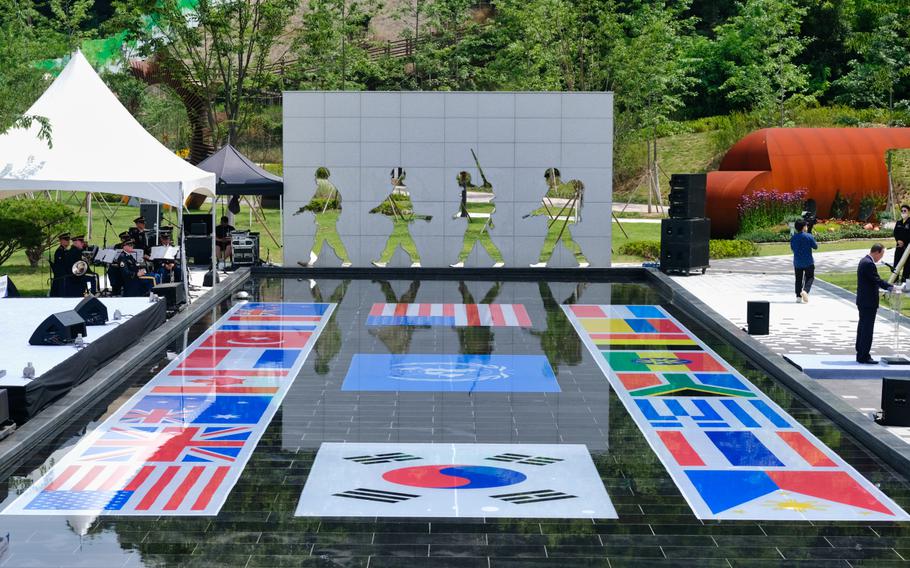
Flags of the nations that fought for the Allies in the Korean War are displayed in a pond during a memorial service at Osan Jukmiryeong Peace Park in Osan, South Korea, Sunday, July 5, 2020. (Matthew Keeler/Stars and Stripes)
OSAN, South Korea — It was raining 70 years ago when American soldiers engaged in their first ground battle against North Korean forces, just over a week after the Korean War began.
That meant the Air Force couldn’t provide cover as the 540 members of Task Force Smith fought more than 5,000 North Koreans armed with Soviet-made tanks.
More than 150 Americans were killed or went missing in the fighting on July 5, 1950, known as the Battle of Osan. But the unit accomplished its mission to help delay the North Korean advance while U.S. reinforcements arrived on the divided peninsula.
U.S. and South Korean officials gathered Sunday in Osan, about 30 miles south of Seoul, to commemorate the 70th anniversary of the battle, saying it also marked the beginning of the longstanding alliance between the two countries.
“Task Force Smith’s actions signaled that the free world would not stand by idly and watch communist aggression towards the Republic of Korea,” Gen. Robert Abrams, commander of U.S. Forces Korea, said during the ceremony, using the formal name for South Korea.
“Their actions inspired nations from around the world, and the [South Korean]-U.S. alliance emerged from the embers of war,” he added.
Osan city also inaugurated the Jukmiryeong Peace Park and an expanded museum in memory of the battle, with dancers and a flyover by the Black Eagles, a South Korean military aerobatic team.
Surviving American veterans from Task Force Smith have appeared at past commemorations, but travel and attendance this year was limited by the coronavirus pandemic. Everybody at the ceremony wore face masks.
Abrams paid homage to retired Maj. Gen. Yoon Seung-kook, who as a young captain was the only South Korean assigned to the unit. USFK also recently renamed an access gate at Camp Humphreys in honor of Yoon, now 95.
The U.S. came to the aid of South Korea shortly after the war began on June 25, 1950, but it initially relied mainly on air and naval support.
The Korean War saw many deadlier battles, but Osan was significant because it marked the start of broader international engagement.
“It showed this is no longer just a Korean conflict. Now you’ve got American forces with, as the saying goes, with skin in the game,” said Cord Scott, an Osan-based history professor with the University of Maryland Global Campus. “It exemplifies the expansion of the war under the U.N. guise.”
Task Force Smith was a hastily assembled and understrength battalion sent from the 24th Infantry Division in U.S.-occupied Japan after the United Nations Security Council authorized military action by member states.
The outnumbered soldiers were ill-prepared against the better-equipped North Koreans but held the ground for more than six hours before commander Lt. Col. Charles Smith ordered a retreat.
“Because it’s raining, the U.S. can’t provide air cover and if you don’t have air cover, especially back in the 1940s and 50s, you really can’t take on a tank with a recoilless gun or an artillery piece,” he said.
In all, 22 nations contributed combat forces or medical support under U.N. auspices to the fight against the North Koreans, who were later joined by Chinese forces.
The U.S. maintains at least 28,500 service members in South Korea after the war ended on July 27, 1953, with an armistice instead of a peace treaty.
keeler.matthew@stripes.com Twitter: @MattKeeler1231
gamel.kim@stripes.com Twitter: @kimgamel